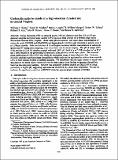| dc.contributor.author | Keene, William C. | |
| dc.contributor.author | Mosher, Byard W. | |
| dc.contributor.author | Jacob, Daniel James | |
| dc.contributor.author | Munger, J. William | |
| dc.contributor.author | Talbot, Robert W. | |
| dc.contributor.author | Artz, Richard S. | |
| dc.contributor.author | Maben, John R. | |
| dc.contributor.author | Daube, Bruce C. | |
| dc.contributor.author | Galloway, James N. | |
| dc.date.accessioned | 2015-03-12T14:53:24Z | |
| dc.date.issued | 1995 | |
| dc.identifier.citation | Keene, William C., Byard W. Mosher, Daniel J. Jacob, J. William Munger, Robert W. Talbot, Richard S. Artz, John R. Maben, Bruce C. Daube, and James N. Galloway. 1995. “Carboxylic Acids in Clouds at a High-Elevation Forested Site in Central Virginia.” Journal of Geophysical Research 100 (D5): 9345. doi:10.1029/94jd01247. | en_US |
| dc.identifier.issn | 0148-0227 | en_US |
| dc.identifier.uri | http://nrs.harvard.edu/urn-3:HUL.InstRepos:14121782 | |
| dc.description.abstract | During September 1990 we sampled coarse (>18-μm diameter) and fine (18- to 5.5-μm diameter) droplets and liquid-water content (LWC) in cloud from a tower on a forested ridge top in Shenandoah National Park, Virginia. Cloud-water pH and aqueous- and vapor-phase concentrations of carboxylic acids (HCOOH and CH3COOH) and formaldehyde (HCHO) were measured in parallel over 1- to 1.5-hour intervals. Both size fractions of cloud droplets contained similar concentrations of carboxylic species and H+ during most sampling; most cloud water was in coarse droplets. The pH of coarse (3.27–4.76) and fine (3.22–4.70) droplets coupled with total LWC of 0.04–0.56 g m−3 STP (standard m3 at 0°C and 1 atm) resulted in the partitioning of carboxylic acids primarily in the vapor phase. The observed phase partitioning for CH3COOH was within the uncertainty range of thermodynamic data. However, HCOOH exhibited significant phase disequilibria, which could not be explained by artifacts from variable LWC or from mixing droplets of different acidities. We hypothesize that the large volume of liquid water deposited on the forest canopy interacted with the near-surface cloud leading to apparent disequilibria based on time-integrated samples. HCOOH was selectively depleted relative to CH3COOH in cloud, particularly at higher pH, suggesting rapid removal of HCOOH by cloud-water deposition. We saw no evidence for significant production of HCOOH from the aqueous-phase oxidation of HCHO. | en_US |
| dc.description.sponsorship | Engineering and Applied Sciences | en_US |
| dc.language.iso | en_US | en_US |
| dc.publisher | Wiley-Blackwell | en_US |
| dc.relation.isversionof | doi:10.1029/94JD01247 | en_US |
| dash.license | LAA | |
| dc.title | Carboxylic acids in clouds at a high-elevation forested site in central Virginia | en_US |
| dc.type | Journal Article | en_US |
| dc.description.version | Version of Record | en_US |
| dc.relation.journal | J. Geophys. Res. | en_US |
| dash.depositing.author | Jacob, Daniel James | |
| dc.date.available | 2015-03-12T14:53:24Z | |
| dc.identifier.doi | 10.1029/94JD01247 | * |
| dash.contributor.affiliated | Munger, J. | |
| dash.contributor.affiliated | Jacob, Daniel | |


